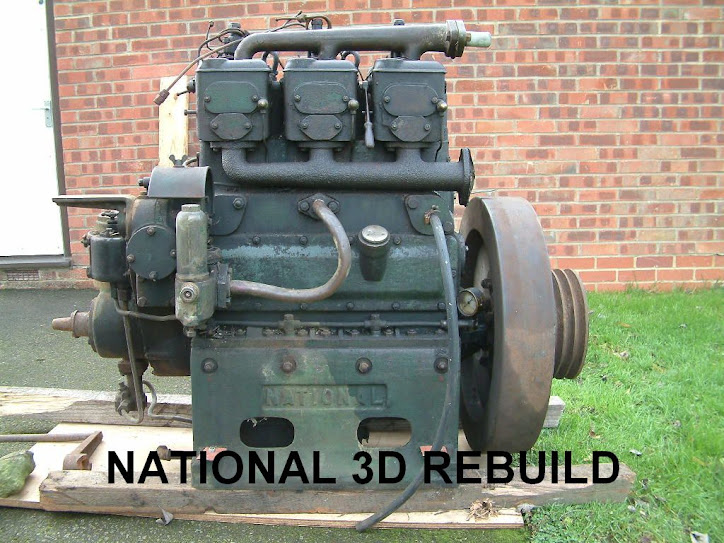My parents have been over from 'Europe' (they live on a Dutch Barge - of no fixed abode) so I have been entertaining and talking boats/engines etc.
Mini and Vix - you'll be glad to know that this entry is not about rushing in with hammer and spanner, but thinking about engineering solutions for the future.
Long discussions took place about how to connect the engine to a gearbox/prop.
It sounds simple enough, but, as the 3D is an industrial engine the non flywheel end of the engine had the hand start dog fitted to it. A large triple vee belt pulley was bolted to the flywheel which was the power end of the engine.
Obviously, a genuine marine engine (see Warriors 3DM) had a different configuration at the non flywheel end of the crankshaft to allow the coupling of a gear box. So what to do?
The first decision has to be which way round to face the engine. The most common configuration for 'traditional' marine engines is to have the flywheel at the bow end and the gearbox connected to the non flywheel end. That said, as the years progressed and the basic engine block for both marine/automotive and stationary use became common, the flywheel often found its way to the gearbox end of the engine (often found on Gardners). In modern engines this is almost now the standard configuration.
Many marinised 'stationary' vintage engines have the gearbox at the flywheel end as this is usually the easiest engineering solution. It also protects the engine should the prop suddenly strike an object and stop suddenly. Something has to 'give' to absorb the stored energy in the flywheel. Better a bent prop blade/stripped gear/bent shaft rather than snapping the crank in your prized vintage engine!
The other decision has to be gearbox/prop shaft arrangements.
- A close coupled prm type gearbox
- A remote gearbox with double propshafts (as fitted to NB 'Hadar').
- Pure hydraulic drive system (hyd' pump bolted to the engine - hyd' motor down by the stern gland)
Above are NB Hadar's 'remote gearbox, using two shorter shafts reduces shaft torque 'wind up' and vibration
I'm fairly sure that current DM2 RN's use a prm 150 gearbox (not sure of the reduction ratio). I contacted prm and they advised that a prm 260 should be used due to the additional power/torque of the 3 cylinder engine.
If I use a prm 260 it would be a 2:1 reduction ratio. That would mean prop speeds of 125 to 500 rpm, which in turn will need a large diameter/pitch prop. If I went up to a prm 500, I could get it in 1.5:1 reduction. This would mean prop speeds of 167 to 667 rpm, thereby needing a smaller diameter/pitch prop.
A prm 260 is £1,200, a prm 500 is £1,800. Cheaper gearbox - bigger prop/shaft etc. More expensive gearbox - smaller prop etc.
I've emailed Crowthers with my dilemma, to see what they can advise regarding ratios, props, shafts and stern gear. No response yet, I'll give it a week and then follow it up with a phone call.
Why am I worrying about this now you may ask? Well, I have a plan that may see a close coupled gearbox on the non-flywheel end of the engine (trad' configuration), but it will need the non flywheel end of the crankshaft machining and an output flange fitting. If I adopt this plan, the work needs to be done when the crank is sent away for its regrind.
Of course - If one uses the pure hydraulic drive system all of the above is solved. Basic systems start from around £2,500 though. I'm not sure about the efficiency of the hydraulic drive system as well.
I am now going to sit back and await detailed comments from you blogger's with regard to the best solution........ Please?



1 comment:
If it's any help Steve, a 3 pot Ruston spins my PRM260 on a 1.5:1 reduction with a 22 x 17 x 3 blade prop which has a 70% blade area. It's a crother special.The engine does about 750 rpm at normal canal speed, but when you open her upon the river she really shifts some water. Over heating can be a problem on the larger 3 pot engines
Post a Comment